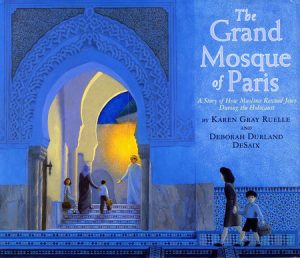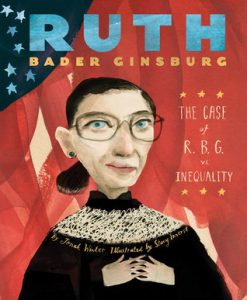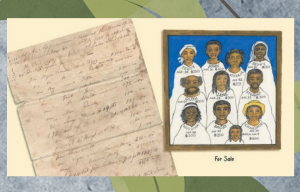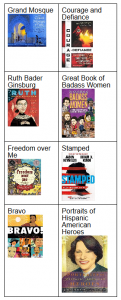by Charlene Klassen Endrizzi with Karen Matis
This week we continue our exploration of “Hidden Stories” by revealing historical personalities too often overlooked. We zero in on adolescent books highlighting change agents chosen by history preservice teachers.
“I took many history courses in high school and college. Why have I never heard of these events?” (Makenzie, history major). This refrain, in response to Isabel’s Learning Invitation on the nonfiction book The grand mosque of Paris: A story of how Muslims rescued the Jews during the Holocaust (Ruelle, 2010), became a familiar response as we delved further into our hidden stories exploration.
Expanding the curriculum to include a more culturally responsive view of historical events is evident in Isabel’s use of the U.S. Holocaust Museum website that includes the French Muslims’ rescue of many Jews. Questions from the website Some Were Neighbors such as: “What motives and pressures led so many individuals to abandon fellow human beings? Why did others make the choice to help?” promote more comprehensive units. Adolescents deserve to examine multiple lenses offered by diverse individuals, seen in this Muslim-Jewish relationship.
In solidarity with Jews, Muslim rectors like Si Kaddour Benghabrit placed themselves in peril to prevent the deportation of Jewish women, men and children to concentration camps. Selfless acts by Benghabrit segway into relevant explorations of current events, such as detention centers made to house children of asylum seekers at the U.S.-Mexico border in 2018. Isabel’s thoughtful questions like “What are human rights?” or “How can we work together to promote human rights?” encourage teachers to explore little-known, hopeful stories across time and cultures.
Author Karen Ruelle’s research into this Muslim-Jewish interaction, evident in her extensive bibliography of books, films and websites, offers teachers opportunities for further investigation. Videos featured on The Grand Mosquee de Paris website allow readers to compare Deborah DeSaix’s illustrations, filled with vibrant blues, purples and greens, against the renovated mosque today. Her artwork conveys the peaceful nature of life behind mosque walls.
Our nation mourned the loss of a notorious change agent this September. Ruth Bader Ginsburg quietly yet courageously epitomized the notion of dissent. To dissent and overcome lies at the heart of our nation’s current social justice movement. Makenzie chose to honor Ruth’s tireless 27 year term on the Supreme Court by exploring Ruth Bader Ginsburg: The case of RBG vs. inequality (Winter, 2016).
Jonah Winter’s text opens with, “Ladies and gentleman of the jury: During this trial you will learn about…an unfair world… where boys were valued more than girls…” (2016). Makenzie’s invitation nudged classmates to examine Winter’s aggressive tone and how his word choice, peppered with notions of dissent, encourages adolescents to consider the past through another pair of glasses – Ruth’s.
The teaching app, Pear Deck, recently teamed up with PBS NewsHour to offer digital resources for teachers. Their study of RBG’s legacy aptly augments Makenzie’s invitation. Her central question, “How can one person bring about change and make a difference?” helps other preservice teachers investigate the slow yet resolute work of RBG.
The spotlight of valor in Benghabrit’s and Ginsburg’s legacies continues in our next biography – Freedom over me: Eleven slaves, their lives and dreams (Bryant, 2016). Master storyteller and illustrator Ashley Bryant illuminates the never-ending dream of freedom seen through the eyes of eleven slaves. Hope’s Learning Invitation focused on Bryant’s cry, “Freedom, Oh Freedom,” to portray the hard history seen in one dire illustration – eleven human beings with attached price tags. Bryant’s text emerges from a grim primary source – Cado Fairchilds’ Appraisement of the Estate document, dated July 5, 1828.
Classmates’ responses to Hope’s invitation centered on their disdain for the heartless owner, Mary Fairchilds. Hope focused on the dream of freedom to emphasize the slaves’ dignity. Bryant offers readers two poetic perspectives of each person, starting with an exterior lens emphasizing prized skills followed by an inner lens featuring life transcending the estate. The text opens with an exploration of the estate cook’s (Peggy) life, as she outlines her owner’s praise for her culinary skills. Bryant broadens our lens on Peggy by offering a glimpse of her inner dreams centered on her knowledge of healing herbs to treat friends’ ailments and injuries. These eleven life stories can evolve into a close up look at “hard history”. Teachers might also use Teaching Tolerance’s podcast series Teaching Hard History Podcast to explore the brutal legacy of slavery.
This week’s last text centers around an overlooked ethnic group, the Latinx community. Makenzie selected Margarita Engle’s Bravo: Poems about amazing Hispanics (2017) in her search for relevant, relatable texts to reconsider lessons from our past.
Like Bryant, Engle uses poetry to highight accomplishments of Latinx historical personalities. Makenzie’s invitation featured relatable poems she felt offered adolescents points of connection. For example, Engle’s poem featuring Tito Puente, the King of Latin jazz, highlights his love of music starting in childhood. Engle describes how Tito made neighbors crazy with his constant drumming “on pots, pans, windows and walls”. Makenzie used this poem and others to offer potential points of connection for adolescents. Another timely Engle poem frames a call for nonviolent protests offered by Cesar Chavez. In Sharing Peace, Chavez’s insistence on peaceful demonstrations is clearly heard – “I still see the need for change, but I don’t believe in fighting with weapons or fists, so change comes slowly, as I lead other farmworkers in nonviolent protests, marches, strikes, boycotts, and voting” (2017). Examining Chavez’s work during an inquiry into our Civil Rights and Black Lives Matter protests can build bridges of understanding between the past and present.
Illustrator Rafael Lopez’s decision to present Latinx musicians, activists, botanists, and more through portraits looking us directly in the eye make these change agents appear accessible and relevant. Bold, bright portraits of memorable Hispanics facing life’s challenges offer visual images that invite discussion. Mackenzie’s closing thought, “to think about the relevance of the past”. reminds me of the need for teachers who share content knowledge that is culturally sustaining and responsive (Gay, 2018).
The four picture book biographies offered this week, when paired with longer nonfiction texts seen in the chart below, encourage history teachers to use little-known hidden stories of courageous activists to initiate units of study. Preservice teachers’ like Isabel, Mackenzie and Hope encourage teachers to launch their own search for relevant texts.
Reference
Gay, G. (2018). Culturally responsive teaching: Theory, research, and practice (3rd ed.). New York, NY: Teachers College Press.
Journey through Worlds of Words during our open reading hours: Monday-Friday, 9 a.m. to 5 p.m. and Saturday, 9 a.m. to 1 p.m. To view our complete offerings of WOW Currents, please visit its archival stream.
- Themes: Charlene Klassen Endrizzi, Karen Matis
- Descriptors: Books & Resources, WOW Currents






I find your essential questions (What motives and pressures led so many individuals to abandon fellow human beings? Why did others make the choice to help?) extremely powerful as they can be explored across disciplines, generations, and time periods.
I love your continued focus on the stories left unfold and specific texts that can bring about awareness, change, and action. To me, it’s an exciting journey to find texts that provide wide awakeness and opportunity for ongoing reflection about identity and life.
I love Stamped and am thrilled they are making a Stamped for Kids edition as well.
I love to read literature that helps my students understand empathy. We need A LOT more of that in our world today. The essential question “Why did others make the choice to help?” really helps to facilitate a discussion about empathy. I have a unique group of students this year (12 girls and 5 boys). All of them are very interested in current events, and would love to read more about Ruth Bader Ginsburg. I also am very interested in the title “Great Book of Badass Women” for this great group of young women in my classroom. I am pondering how to adapt the title for fourth graders 🙂 Perhaps “Great Book of Strong-willed Women” ??
Maria, Your insights emphasizing awareness nudge students toward Kayla’s hope of encouraging greater empathy. As I re-read all too often hidden yet hopeful stories of Muslim rectors, RBG, Peggy and Tito, I hope to further accentuate their dignity in the midst of hard times, not so different from our current national struggles. Chavez reminds us, “Change comes slowly,” through teachers like you and Kayla, who inspire students to consider opportunities that make a small difference in their community.
Many of these stories are new to me! What a wonderful idea to use these inspirational books as means of encouraging investigation and self-discovery. There are so many wonderful resources available for teachers to explore with their students. Such stories connect students with the essential question of ‘Who am I, and who do I want to be in the future?’. Understanding the perspectives of others is the first step in this journey, and these books provide an exciting pathway to do so.